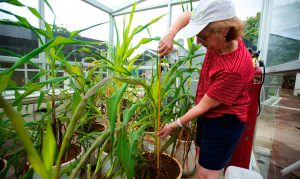
The archaeobotanical program at STRI officially began in 1988 when Dolores Piperno was hired to the scientific staff. She had previously worked at STRI for several years as a pre-doctoral and then post-doctoral fellow, with her Master’s thesis and dissertation research focused on phytoliths from archaeological and geological sites in Panama. The program has over time built large modern reference collections of Neotropical macro-botanical materials, phytoliths, and starch grains. The latter two are primarily focused on due to the poor preservation of macrobotanical remains in archaeological sites from the humid tropical forest. The two lines of microfossil research have proved to be highly informative and complementary; for example, manioc and other root crops are difficult to identify with phytoliths but produce high numbers of diagnostic starches easily isolated from stone tools and human teeth. Some seed crops such as Phaseolus beans that don’t produce useful phytoliths make numerous diagnostic starch grains.
During the past five years Piperno and STRI colleague Irene Holst have carried out phytolith and starch grain research on archaeological and natural sediments, stone tools, and human teeth from a number of Neotropical sites. Phytolith research with natural soils sampled from underneath extant interfluvial forest in Amazonia by collaborator Crystal McMichael (University of Amsterdam) is documenting the scale and intensity of prehistoric influences on the forests during the past 7000 years. A novel experimental project initiated ten years ago and still on-going examines phenotypic and genetic (transcriptomic) change in maize and lima bean domestication by growing their wild ancestors in the lower atmospheric CO2 and temperature levels that occurred from ca. 13,000 to 9,000 years ago when Neotropical peoples last collected and first cultivated plants. The project is revealing how maize’s ancestor, teosinte, was considerably different in phenotypic characteristics, surprisingly having some important maize traits previously thought to have been a product of domestication. Whole transcriptome (RNAseq) studies by Piperno’s genetic collaborators Jeff Ross-Ibarra (University of California, Davis) and Matthew Hufford (Iowa State) also reveal how the expression (activity) of a number of genes known to control domestication traits differed in the past environments.